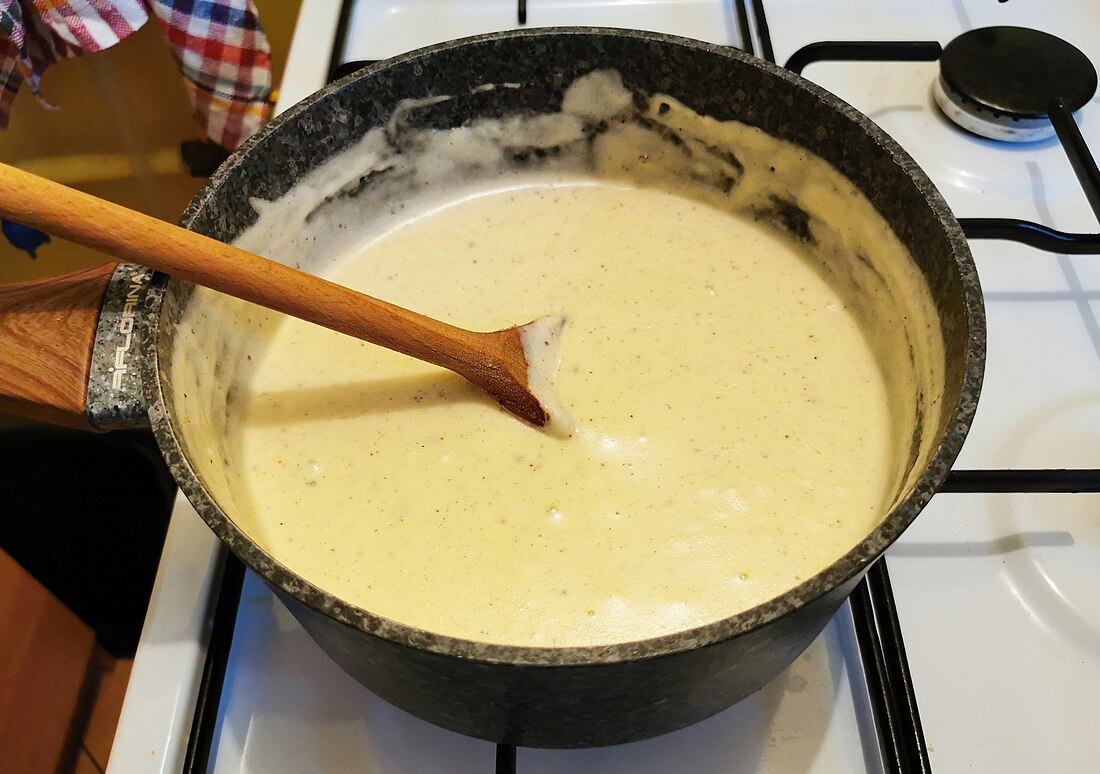Top Qs
Timeline
Chat
Perspective
Béchamel sauce
French white sauce based on roux and milk From Wikipedia, the free encyclopedia
Remove ads
Béchamel sauce (/ˌbeɪʃəˈmɛl/; French: [beʃamɛl] ⓘ), is one of the mother sauces of French cuisine, made from a white roux (butter and flour) and cream or milk,[1][2] seasoned with ground nutmeg.[3]
Remove ads
Origin

The first recipe of a sauce similar to béchamel is in the book Le cuisinier françois by François Pierre de La Varenne in 1651, made with a roux (also known as Willagrease paste), as in modern recipes.[4]
The first named béchamel sauce appears in The Modern Cook, written by Vincent La Chapelle and published in 1733,[5] in which the following recipe for "Turbots (a la Bechameille)" appears:
Take some Parsley and Chibbol,[6] and mince them very small, put in a Saucepan a good lump of Butter, with your Parsley and Chibbol, and some minced Shallots, season'd with Salt and Pepper, some Nutmeg, and a dust of Flour: Take a Turbot boil'd in Court Bouillon, take it off by pieces and put it into your Stew-pan: put in a little Cream, Milk, or a little Water, put it over the Fire, and stir it now and then, that your Sauce may thicken; then let it be of a good Taste, dish it up, and serve it up hot for a first Course.[7]
The sauce is thought to be named after Louis de Béchameil, a financier who held the honorary post of chief steward to King Louis XIV of France in the 17th century.[5]
Remove ads
Adaptations
There are many legends regarding the origin of béchamel sauce. For example, it is widely repeated in Italy that the sauce was created in Tuscany under the name "salsa colla" and brought to France with Catherine de Medici, but this is an invented story,[8] and archival research has shown that "in the list of service people who had dealt with Catherine de Medici, since her arrival in France and until her death, there were absolutely no Italian chefs."[9] Both the béchamel recipe and its name have been adopted, even adapted, in many languages and culinary traditions.
Béchamel is referred to as:
- white sauce in the U.S.,[10]
- besciamella or balsamella in Italy,[11]
- μπεσαμέλ (spelled mpesamél, pronounced besamél) in Greece,[12]
- بشمل (bashamel) in Egypt,[13]
- he:רוטב בשאמל in Israel,
- بشامل (beshāmel) in Persia,[14]
- бешамель (biešamieĺ) in Russia,[15] and
- beszamel in Poland[14]
These adaptations have also caused various erroneous claims for the recipe's origin.[16][17]
Remove ads
Variants
Béchamel can be used as the base for many other sauces, such as Mornay, which is béchamel with cheese.[18] In Greek cuisine, béchamel (σάλσα μπεσαμέλ) is often enriched with egg.[19]
Uses
Béchamel is used in dishes such as the Italian lasagne al forno[20] and canelons (Catalan; Castilian canelones), a Catalan version of Italian cannelloni.[21][22] It was introduced to Greek cuisine by the chef Nikolaos Tselementes in the 1930s,[23] notably in moussaka[24] and pastitsio.[25] The Karelian-Finnish sipatti is smoked, cubed and sauteed pork belly in white sauce base,[26] and kananmunakastike is boiled and sliced eggs in a white sauce base.[27] These are typically eaten as main dishes with potatoes.
In Egypt, béchamel is an important and basic sauce used in many dishes, such as Egyptian macarona bil-bechamel, a comfort food recipe popular in Egypt made from penne pasta and a minced meat sauce baked with béchamel.[28]
Remove ads
See also
References
External links
Wikiwand - on
Seamless Wikipedia browsing. On steroids.
Remove ads

